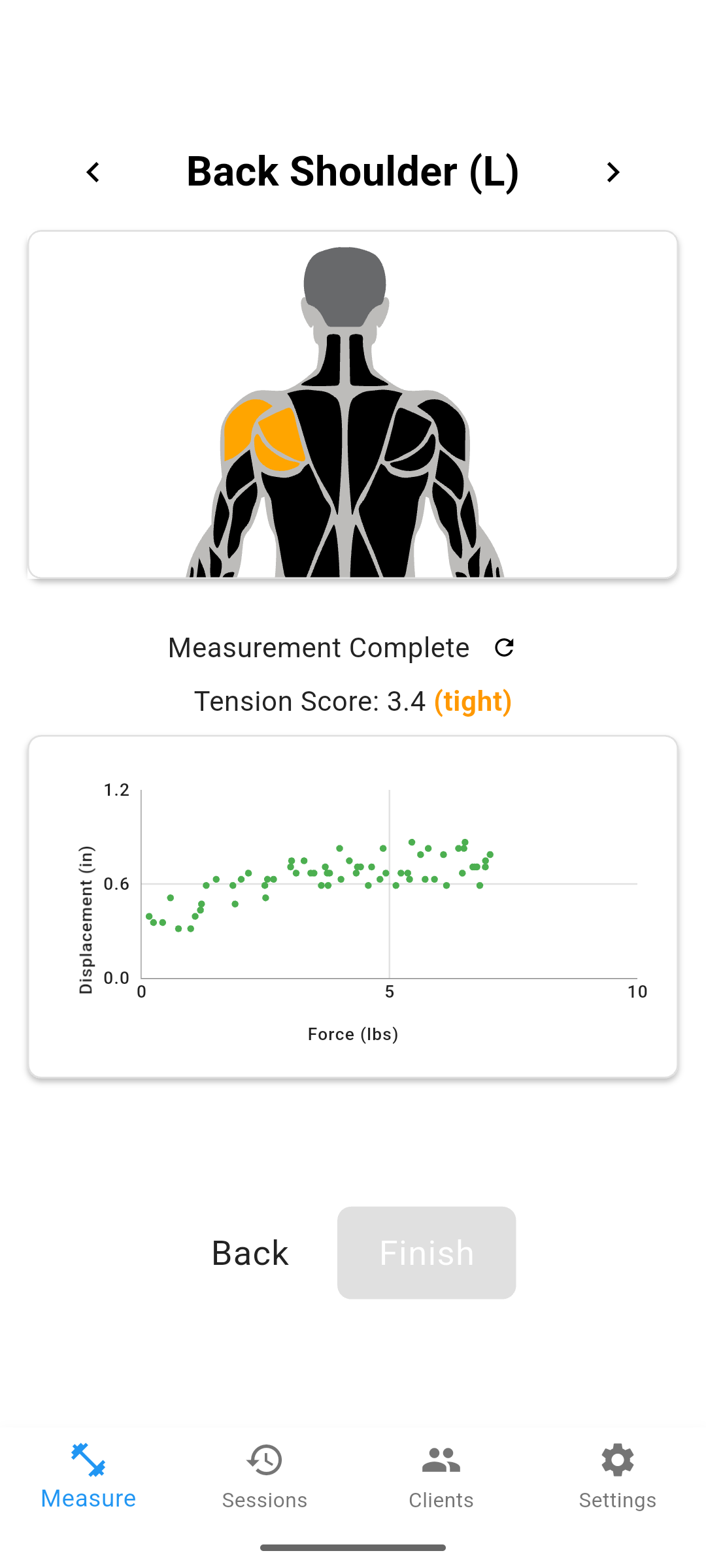What the MuscleMapper Can (and Can't) Do
Before we get into the details of what MuscleMapper measures, here's a quick overview.
The MuscleMapper is a handheld device designed to measure muscle tension. By "tension," we mean how much a muscle pushes back when you apply pressure. To measure this, the device records two things:
- The force applied to the muscle
- How much the muscle moves (displaces) in response

What MuscleMap Measures
MuscleMap focuses on the muscle belly, the contractile tissue that sits beneath skin and fat. This is the same "push-back" you feel when you press your finger into a muscle.
The device collects force and displacement data. But not all of that data comes from the muscle belly. Some of it comes from skin, fascia, or subcutaneous fat. To handle this, MuscleMap runs an analysis on the full force-displacement curve. It identifies which section represents the muscle belly and then calculates a tension score from that segment.
See How It Works for a breakdown of how the score is created.
What It Doesn't Measure
There are important things MuscleMap doesn't measure:
- Soreness – how tender a muscle feels to touch. This isn't purely physical; it's influenced by local tissue chemistry and how the brain interprets those signals.
- Range of motion (ROM) – how far a joint can move comfortably. ROM depends on many factors, and often leans more neurological than purely mechanical.
See Why Your Muscles "Feel Tight" (Even If They Aren't)
Another thing MuscleMap doesn't measure is tissue oscillation or elasticity—basically, how much the tissue "wobbles" after being tapped. Other tools, like the MyotonPRO, measure this by applying a quick mechanical tap to the skin and recording how the tissue vibrates.
- Pros: Fast, repeatable, and widely used in research.
- Cons: It mainly reflects what's happening in the superficial layers. For example, in regions like the erector spinae—where the muscle sits beneath the thick thoracolumbar fascia—the readings can be dominated more by fascia than by the muscle belly itself.
By contrast, MuscleMap uses a slow press to measure how much the tissue resists displacement (stiffness). That makes it more suited to looking at muscle belly resistance, especially in areas where fascia would otherwise mask the signal.
See MuscleMap vs. Alternatives
Why Can't I Measure Every Muscle?
Right now, MuscleMap supports a set of larger, clinically useful muscles. Some regions are simply too small, thin, or surrounded by tricky structures for clean, repeatable readings. To keep the workflow fast and reliable, we started with the most commonly requested sites.
We also create muscle profiles for each region. These are weighting models built from testing a sample of muscles to figure out which part of the force–displacement curve represents the muscle belly most accurately. In other words, every time we add a new muscle region, we need to develop a custom profile so the device knows how to interpret the data. That's why expanding to new regions takes time.
If there's a region you really want to see, email [email protected]!
Current Supported Muscles (both left and right):
- Upper Traps & Neck
- Lower Traps
- Front Delts
- Chest
- Back Shoulders
- Biceps
- Triceps
- Forearms
- Lats
- Quads
- Hamstrings
- Calves
- Front Lower Leg (shin)
- Glutes
Other Limitations
Like any measurement tool, MuscleMap isn't perfect. A few sources of "noise" can affect the readings:
- User technique: The device needs to be pressed slowly and perpendicular to the skin. Tilting the disk or pressing too quickly can throw off the data.
- Sensor noise: The displacement sensor and load cell both have a small amount of electronic noise built in. While we filter and average the signals, some variability is inevitable.
- Client factors: If the client suddenly relaxes or tenses the muscle during a measurement, that change shows up in the curve and can affect the score.
We design around these limits by focusing on repeatable workflows and filtering, but it's worth keeping in mind that no measurement is 100% noise-free.
See Tips for Accurate Measurements
Why We Still Built It
MuscleMap does not capture the full picture of a muscle, and no tool can guarantee 100% accuracy. What it does provide is something that is often missing in hands-on work: an objective measure of muscle tension.
That is valuable for two big reasons:
- Client trust and communication – Clients often describe their muscles as "tight," but that word can mean very different things. Having a clear number helps shift the conversation from a vague feeling to something concrete. Even if the result confirms that tension is normal, the ability to show rather than just tell builds confidence and trust.
- Tracking progress over time – A single measurement is useful, but the real power comes from seeing trends. Clients might not notice day-to-day changes, but when you can pull up a graph showing how their muscle tension has decreased over several sessions, it makes progress visible. That visibility helps motivate clients to stick with their care plan and reminds them that their efforts are paying off.
At the end of the day, MuscleMap is not about replacing your hands or judgment. It is about giving you one more tool: a physical, objective metric you can use to communicate more clearly, track progress, and build stronger client relationships. That mission, bringing clarity and trust to muscle care, is why we built it.
Citations
- Superficial vs. deep tissue measurement limits (MyotonPRO overview)
https://myoton.com/technology/ - Small / thin muscle limitation (<3 mm thickness, MyotonPRO)
https://myoton.com/technology/ - Layered tissue crosstalk – phantom study showing masking effects
https://www.nature.com/articles/s41598-023-27742-w - Oscillation vs. stiffness differences – MyotonPRO vs. elastography
https://onlinelibrary.wiley.com/doi/10.1111/sms.70095 - General measurement error and noise in sensors
https://arxiv.org/abs/1004.0874 - Massage decreases upper trapezius stiffness (5-week intervention, elastography) – Jelen et al. (2024). The effect of a 5-week therapeutic massage on erector spinae and upper trapezius muscle stiffness as determined by shear-wave elastography: a randomized controlled trial.
https://pubmed.ncbi.nlm.nih.gov/39253625/
